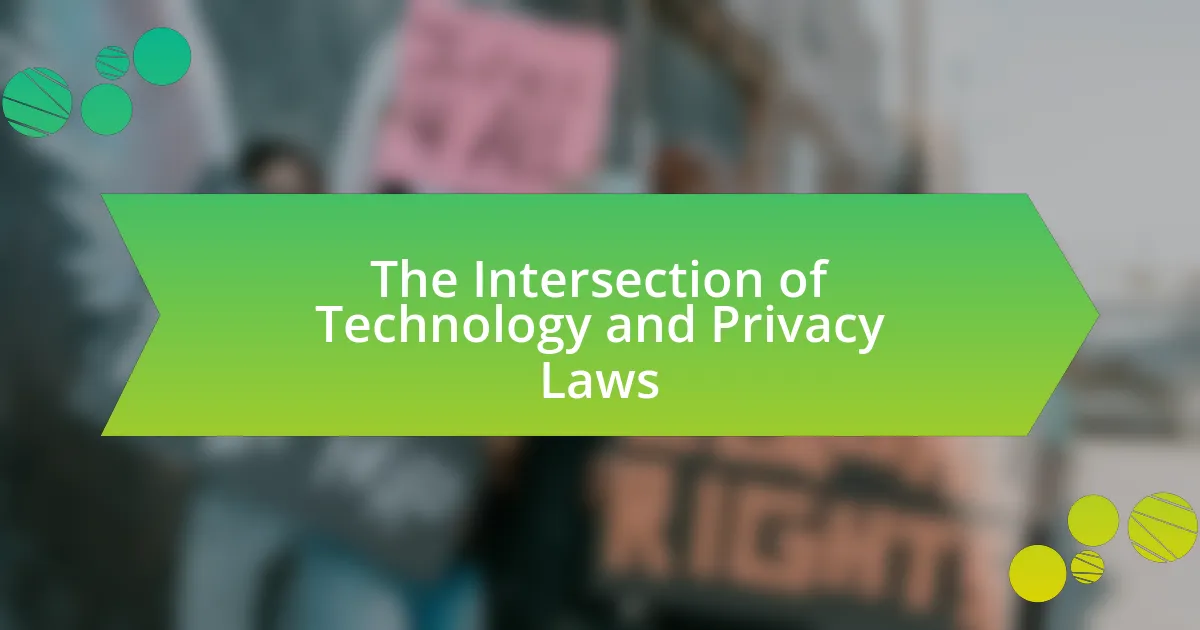The article examines the evolution of labor laws in the context of the gig economy, focusing on the legal frameworks that govern the rights and responsibilities of gig workers engaged in short-term, flexible jobs facilitated by digital platforms. It highlights key historical events that have shaped labor laws, such as the Industrial Revolution and the establishment of labor unions, and discusses how the rise of the gig economy has challenged existing regulations regarding worker classification, benefits, and protections. The article also addresses recent legislative changes, such as California’s Assembly Bill 5, and explores the ongoing debates surrounding the classification of gig workers, the impact of technology on labor laws, and the future trends that may influence worker rights and protections in this rapidly evolving labor landscape.

What are Labor Laws in the Context of the Gig Economy?
Labor laws in the context of the gig economy refer to the legal frameworks that govern the rights and responsibilities of workers engaged in short-term, flexible jobs typically facilitated by digital platforms. These laws address issues such as worker classification, minimum wage, benefits, and workplace protections, which have become increasingly relevant as gig work grows. For instance, in California, Assembly Bill 5 (AB5) was enacted to expand the definition of employees, impacting gig workers by requiring companies like Uber and Lyft to provide benefits traditionally reserved for full-time employees. This legislative shift highlights the ongoing evolution of labor laws to adapt to the unique challenges posed by the gig economy.
How have labor laws historically evolved in response to economic changes?
Labor laws have historically evolved in response to economic changes by adapting to shifts in labor markets, technological advancements, and societal needs. For instance, during the Industrial Revolution, labor laws emerged to address the exploitation of workers in factories, leading to regulations on working hours and conditions. In the late 19th and early 20th centuries, the rise of labor unions prompted legislation such as the Fair Labor Standards Act of 1938, which established minimum wage and overtime pay, reflecting the economic necessity for worker protections. More recently, the gig economy has spurred discussions around the classification of workers, prompting legislative efforts like California’s Assembly Bill 5 in 2019, which aimed to extend benefits to gig workers, illustrating how labor laws continue to evolve in response to economic transformations.
What key historical events influenced the development of labor laws?
Key historical events that influenced the development of labor laws include the Industrial Revolution, the establishment of labor unions, and significant legislation such as the Fair Labor Standards Act of 1938. The Industrial Revolution, which began in the late 18th century, led to the rise of factories and poor working conditions, prompting workers to organize for better rights. The formation of labor unions in the 19th century further advocated for workers’ rights, leading to collective bargaining and improved labor standards. The Fair Labor Standards Act established minimum wage, overtime pay, and child labor protections, marking a significant advancement in labor rights. These events collectively shaped the legal framework governing labor relations and worker protections.
How did the rise of the gig economy challenge existing labor laws?
The rise of the gig economy challenged existing labor laws by creating a workforce that operates outside traditional employment frameworks, leading to ambiguities in worker classification. Gig workers, often classified as independent contractors, lack access to benefits and protections typically afforded to employees, such as minimum wage, overtime pay, and unemployment insurance. This shift has prompted legal debates and legislative efforts, as seen in California’s Assembly Bill 5, which aimed to extend employee status to many gig workers, highlighting the struggle to adapt labor laws to new economic realities.
What defines the gig economy and its workforce?
The gig economy is defined by a labor market characterized by short-term, flexible jobs often mediated through digital platforms. This workforce consists of independent contractors, freelancers, and temporary workers who engage in various tasks or projects rather than traditional, full-time employment. According to a 2021 report by the McKinsey Global Institute, approximately 36% of U.S. workers engage in gig work, highlighting the significant role this economy plays in modern labor dynamics. The gig economy’s structure allows for increased flexibility and autonomy for workers, but it also raises questions about job security and benefits, which are critical issues in the ongoing evolution of labor laws.
What types of jobs are included in the gig economy?
The gig economy includes various types of jobs such as freelance work, ride-sharing services, food delivery, and short-term contract positions. Freelancers often provide services in fields like writing, graphic design, and programming, while ride-sharing jobs are typically associated with companies like Uber and Lyft. Food delivery jobs are commonly offered through platforms like DoorDash and Postmates. According to a report by the McKinsey Global Institute, approximately 30% of the U.S. workforce engages in some form of gig work, highlighting the significant role these jobs play in the modern labor market.
How do gig workers differ from traditional employees?
Gig workers differ from traditional employees primarily in their employment structure and benefits. Gig workers operate on a freelance basis, often through digital platforms, allowing them to choose when and how much they work, while traditional employees typically have fixed schedules and receive consistent salaries. Additionally, gig workers usually lack benefits such as health insurance, retirement plans, and paid leave, which are commonly provided to traditional employees. According to a 2020 report by the Bureau of Labor Statistics, about 36% of U.S. workers engage in gig work, highlighting the growing prevalence of this employment model compared to traditional employment.
Why is the evolution of labor laws important for gig workers?
The evolution of labor laws is crucial for gig workers because it directly impacts their rights, protections, and benefits. As the gig economy expands, traditional labor laws often fail to address the unique challenges faced by gig workers, such as job security, minimum wage, and access to healthcare. For instance, a 2020 report by the International Labour Organization highlighted that gig workers often lack basic labor protections, which can lead to exploitation and financial instability. Therefore, updating labor laws to include gig workers ensures they receive fair treatment and adequate support in a rapidly changing job market.
What rights and protections do gig workers currently lack?
Gig workers currently lack essential rights and protections such as minimum wage guarantees, unemployment benefits, health insurance, and the right to unionize. These workers are often classified as independent contractors, which excludes them from many labor protections afforded to traditional employees. For instance, a 2020 report by the Economic Policy Institute highlighted that gig workers earn significantly less than traditional employees, with many unable to access basic benefits like paid sick leave or retirement plans. This lack of protections has led to increased financial instability and vulnerability among gig workers, underscoring the need for legislative reforms to address these gaps in rights and protections.
How do labor laws impact the economic security of gig workers?
Labor laws significantly impact the economic security of gig workers by determining their classification, benefits, and protections. When gig workers are classified as independent contractors rather than employees, they often lack access to essential benefits such as health insurance, unemployment compensation, and retirement plans, which diminishes their financial stability. For instance, a study by the Economic Policy Institute found that gig workers earn 58% less than traditional employees when accounting for benefits. Additionally, labor laws that enforce minimum wage standards and overtime pay can enhance the economic security of gig workers by ensuring fair compensation for their work. Therefore, the legal framework surrounding gig work directly influences the financial well-being and job security of individuals in this sector.
How are current labor laws adapting to the gig economy?
Current labor laws are adapting to the gig economy by increasingly recognizing gig workers as employees entitled to certain benefits and protections. For example, several jurisdictions, including California with Assembly Bill 5, have implemented legislation that expands the definition of employment to include gig workers, thereby granting them access to unemployment insurance, health benefits, and minimum wage protections. Additionally, the European Union has proposed regulations aimed at improving working conditions for gig workers, emphasizing the need for fair pay and social security. These adaptations reflect a growing acknowledgment of the economic significance of gig work and the necessity for legal frameworks that protect workers in this evolving labor landscape.
What recent legislative changes have been proposed or enacted?
Recent legislative changes proposed or enacted in the context of labor laws in the gig economy include California’s Assembly Bill 5 (AB 5), which was enacted in 2019 and expanded the definition of employee status, making it more difficult for gig companies to classify workers as independent contractors. Additionally, in 2021, New York City passed a law requiring app-based delivery services to provide workers with minimum wage protections and benefits. These changes reflect a growing trend among states to enhance protections for gig workers, aiming to ensure fair compensation and labor rights.
How are different countries approaching gig economy regulations?
Different countries are approaching gig economy regulations through a variety of frameworks, primarily focusing on worker classification, rights, and benefits. For instance, in the United States, regulations vary by state; California’s Assembly Bill 5 mandates that gig workers be classified as employees, granting them benefits, while other states maintain a more flexible classification. In the European Union, the proposed Directive on Transparent and Predictable Working Conditions aims to enhance protections for gig workers, emphasizing their rights to fair wages and working conditions. In contrast, countries like Australia have adopted a more laissez-faire approach, allowing gig platforms to operate with minimal regulation, although there are ongoing discussions about improving worker protections. These varied approaches reflect differing national priorities regarding labor rights and economic flexibility.

What are the Challenges in Regulating Labor Laws for the Gig Economy?
The challenges in regulating labor laws for the gig economy include the classification of workers, enforcement of existing laws, and the adaptability of regulations to rapidly changing work environments. Worker classification is complex, as gig workers often fall into gray areas between independent contractors and employees, complicating their access to benefits and protections. Enforcement is difficult due to the decentralized nature of gig work, where many companies operate across jurisdictions, making it hard to apply consistent labor standards. Additionally, regulations struggle to keep pace with technological advancements and evolving business models, leading to gaps in legal protections for gig workers. These challenges are evidenced by ongoing debates and legislative efforts in various regions, highlighting the need for updated frameworks that address the unique characteristics of gig work.
What obstacles do lawmakers face in creating effective regulations?
Lawmakers face several obstacles in creating effective regulations, including the rapid pace of technological change, conflicting stakeholder interests, and the complexity of existing legal frameworks. The gig economy evolves quickly, making it challenging for lawmakers to keep regulations relevant and effective. For instance, the rise of platforms like Uber and Airbnb has outpaced regulatory responses, leading to gaps in worker protections. Additionally, various stakeholders, such as gig workers, companies, and labor unions, often have conflicting interests, complicating consensus-building. Finally, existing labor laws may not adequately address the unique nature of gig work, requiring lawmakers to navigate a complex legal landscape to create regulations that are both fair and enforceable.
How do varying definitions of gig work complicate regulation?
Varying definitions of gig work complicate regulation by creating ambiguity in categorizing workers and their rights. Different interpretations of gig work, such as distinguishing between independent contractors and employees, lead to inconsistent legal frameworks across jurisdictions. For instance, the California Assembly Bill 5 (AB5) aimed to classify many gig workers as employees, but its implementation faced challenges due to differing definitions of what constitutes gig work. This inconsistency can result in unequal protections and benefits for workers, making it difficult for regulators to enforce labor laws effectively.
What role do technology platforms play in shaping labor law discussions?
Technology platforms significantly influence labor law discussions by redefining employment relationships and challenging traditional labor classifications. These platforms, such as Uber and Airbnb, often categorize workers as independent contractors rather than employees, which affects their access to benefits and protections under labor laws. For instance, a 2020 study by the National Bureau of Economic Research found that gig workers earn less than traditional employees and lack essential benefits like health insurance and retirement plans. This shift prompts lawmakers to reconsider existing labor regulations to address the unique challenges posed by the gig economy, leading to ongoing debates about worker rights and protections.
Why do some stakeholders oppose stricter labor laws for gig workers?
Some stakeholders oppose stricter labor laws for gig workers because they believe such regulations could increase operational costs and reduce flexibility for both companies and workers. For instance, companies like Uber and Lyft argue that classifying gig workers as employees would require them to provide benefits such as health insurance and paid leave, which could significantly raise their expenses. Additionally, many gig workers value the autonomy and flexibility that comes with gig work, and stricter laws could limit their ability to choose when and how much they work. This perspective is supported by surveys indicating that a majority of gig workers prefer the current model over traditional employment due to the freedom it offers.
What arguments do companies make against reclassifying gig workers?
Companies argue against reclassifying gig workers primarily by stating that such a change would disrupt the flexibility and independence that gig work offers. They contend that reclassification would impose traditional employment structures, limiting workers’ ability to choose their hours and work locations. Additionally, companies assert that reclassifying gig workers would lead to increased operational costs, as they would be required to provide benefits such as health insurance and paid leave, which could ultimately reduce job opportunities in the gig economy. For instance, a report from the Economic Policy Institute highlights that the gig economy provides millions of jobs that cater to individuals seeking flexible work arrangements, emphasizing the potential negative impact of reclassification on both workers and businesses.
How do gig workers themselves view potential regulatory changes?
Gig workers generally view potential regulatory changes with a mix of optimism and concern. Many gig workers believe that regulations could provide them with better protections, such as access to benefits and fair wages, which are often lacking in the current gig economy framework. For instance, a survey conducted by the Economic Policy Institute found that 70% of gig workers support regulations that would ensure minimum wage and benefits. However, some gig workers express apprehension that overly stringent regulations could limit their flexibility and independence, which are key reasons they choose gig work. This dual perspective highlights the complexity of gig workers’ views on regulatory changes, balancing the desire for protections with the need for autonomy.

What Future Trends Can We Expect in Labor Laws for the Gig Economy?
Future trends in labor laws for the gig economy are likely to include increased protections for gig workers, such as minimum wage guarantees, access to benefits, and clearer classification of employment status. Legislative movements in various regions, like California’s AB 5, demonstrate a shift towards recognizing gig workers as employees rather than independent contractors, which would entitle them to benefits like unemployment insurance and health care. Additionally, the European Union is considering regulations that would mandate transparency in gig platforms and ensure fair compensation, reflecting a growing global trend towards enhancing worker rights in the gig sector. These developments indicate a significant evolution in labor laws aimed at addressing the unique challenges faced by gig economy participants.
How might labor laws evolve in the next decade?
Labor laws are likely to evolve in the next decade to better address the unique challenges posed by the gig economy. As the gig workforce continues to grow, with estimates suggesting that by 2025, 50% of the U.S. workforce will be involved in gig work, lawmakers may implement regulations that ensure gig workers receive benefits similar to traditional employees. This could include minimum wage protections, access to healthcare, and unemployment benefits, reflecting trends seen in states like California with Assembly Bill 5, which aimed to classify gig workers as employees rather than independent contractors. Additionally, there may be increased emphasis on worker rights and protections against exploitation, driven by public demand for fair treatment and the need for companies to adapt to changing labor dynamics.
What emerging trends in the gig economy could influence future regulations?
Emerging trends in the gig economy that could influence future regulations include the rise of platform cooperatives, increased demand for worker protections, and the integration of technology for better transparency. Platform cooperatives, which are owned and managed by workers, challenge traditional business models and may prompt regulators to consider new frameworks that support worker ownership and rights. Additionally, the growing public awareness of gig worker exploitation has led to calls for enhanced labor protections, such as minimum wage guarantees and benefits, which could drive legislative changes. Furthermore, advancements in technology, such as blockchain for transparent payment systems, could lead to regulatory adaptations that ensure fair compensation and accountability within gig platforms. These trends indicate a shift towards more equitable labor practices, necessitating a reevaluation of existing labor laws.
How might technological advancements impact labor law frameworks?
Technological advancements may significantly reshape labor law frameworks by necessitating new regulations that address the unique challenges posed by the gig economy. For instance, the rise of platforms like Uber and TaskRabbit has blurred the lines between employee and independent contractor status, prompting lawmakers to reconsider definitions and protections under existing labor laws. A study by the National Bureau of Economic Research indicates that gig workers often lack access to benefits such as health insurance and retirement plans, highlighting the need for legal reforms that ensure fair treatment and protections for these workers. As technology continues to evolve, labor laws will likely need to adapt to ensure that workers in the gig economy receive adequate rights and protections.
What best practices can gig workers adopt to navigate labor laws?
Gig workers can adopt several best practices to effectively navigate labor laws, including understanding their rights, maintaining accurate records, and seeking legal advice when necessary. By familiarizing themselves with local labor regulations, gig workers can ensure compliance and protect their rights. Keeping detailed records of hours worked, payments received, and communications with clients can provide essential documentation in case of disputes. Additionally, consulting with legal professionals or labor organizations can offer guidance tailored to specific situations, helping gig workers make informed decisions and advocate for their rights.
How can gig workers advocate for their rights effectively?
Gig workers can advocate for their rights effectively by organizing collectively, utilizing digital platforms for communication, and engaging in advocacy campaigns. Collective organization allows gig workers to unite their voices, increasing their bargaining power and visibility. Digital platforms, such as social media and dedicated apps, facilitate communication and coordination among workers, enabling them to share experiences and mobilize for action. Advocacy campaigns, including petitions and public demonstrations, raise awareness about their rights and push for legislative changes. For instance, the rise of organizations like the Gig Workers Collective has demonstrated the effectiveness of collective action in advocating for better working conditions and legal protections.
What resources are available for gig workers to understand their legal protections?
Gig workers can access various resources to understand their legal protections, including government websites, labor organizations, and legal aid services. For instance, the U.S. Department of Labor provides information on worker rights and protections specific to gig employment. Additionally, organizations like the National Employment Law Project offer guides and resources tailored to gig workers, detailing their rights under existing labor laws. Legal aid services, such as the Legal Services Corporation, also provide assistance and information regarding legal protections for gig workers, ensuring they are informed about their rights and available recourse.






